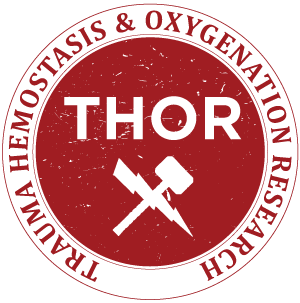EMERGENCY RELEASE LOW TITER GROUP O WHOLE BLOOD IS NOW PERMITTED BY THE AABB STANDARDS
Reducing death from hemorrhage is essential since the mortality for patients with traumatic hemorrhagic shock is high (approximately 20%) and there are approximately 30,000 preventable civilian deaths due to traumatic hemorrhage per year in the US alone. The rationale for the use of group O WB early in the resuscitation of massively bleeding patients is multifactorial and is listed in the table below. The THOR Network and the US Tactical Combat Casualty Care Committee have both indicated that whole blood is the optimal resuscitative product for patients with life-threatening hemorrhagic shock. Its use, especially in the pre-hospital phase of resuscitation, may dramatically reduce preventable deaths.
The AABB (formerly the American Association of Blood Banks) is a professional society for transfusion medicine. Amongst other activities, the AABB develops practice standards against which hospital transfusion services and blood collectors can be voluntarily audited in order to achieve AABB accreditation. These standards specify the conduct of all aspects of the practice of laboratory-based transfusion medicine. Accredited hospitals are required to adhere to the standards, although exceptions to the standards can be made to accommodate local practice variations. In the 30th edition of the standards, standard 5.15.1 specified that whole blood (WB) must be transfused in an ABO-identical manner with the recipient. This is problematic for hospitals that want to use WB in the pre-hospital setting or early in the in-hospital resuscitation of trauma patients when their ABO group is usually unknown.
In September of 2017, a joint THOR-AABB working group submitted a request to change the standard requiring whole blood to be ABO specific with the recipient. In addition to providing a detailed evidence-based rationale for the change, a petition was included that was signed by 217 international experts in the fields of transfusion medicine and resuscitation medicine from 24 countries, who supported a statement in favor of using low titer group O WB in patients with life-threatening hemorrhage. In October of 2017, the AABB’s Standards Committee and Board of Directors approved the request to amend the standard. Standard 5.15.1 in the 31st edition of the AABB standards that will be published in April of 2018 will now indicate that it is permissible to use low titer group O whole blood for recipients of known or unknown ABO group as follows: Recipients shall receive ABO group-compatible red blood cell components, ABO group-specific whole blood, or low titer group O whole blood (for non-group O or for recipients whose ABO group is unknown). The 31st edition of the standards goes on to indicate that the definition of “low titer” shall be made locally by each transfusion service, and that the transfusion service must have a policy specifying which patients are eligible to receive whole blood, the maximum quantity of whole blood per patient, and how to monitor for potential adverse events post-transfusion (standard 5.27.1). With the standards impediments removed, the use of low titer whole blood in civilian patients with massive hemorrhage should now begin in earnest.
BENEFITS OF LOW TITER GROUP O WHOLE BLOOD FOR HEMORRHAGIC SHOCK
Efficacy
- The cold stored platelets provide improved hemostasis compared to room temperature platelets
- Whole blood is a more concentrated product that contains a small quantity of anticoagulant and additive solution than an equal amount of conventional components
Safety
- Reduced risk of hemolysis from the low titer minor incompatible plasma compared to the risk from untitered minor incompatible plasma or platelets
- Reduced risk of bacterial contamination compared to room temperature stored platelets
- Long-standing safety record with over 1 million units transfused in combat and civilian settings
Logistic
- Increased access to platelets for both pre-hospital and early in-hospital resuscitations
- Simplifies the logistics of the resuscitation and accelerates the provision of all blood components needed to treat hemorrhagic shock
CONTACTS:
Philip C. Spinella, MD FCCM
Co-Chair, THOR Network
Co-Chair, AABB-THOR Working Party
Professor, Pediatrics
Director, Translational Research Program
Division of Critical Care, Department Pediatrics
Washington University in St Louis
St Louis, Missouri USA
Email: pspinella@wustl.edu
Geir Strandenes, MD
Co-Chair, THOR Network
Senior Medical Officer
Norwegian Naval Spec. Op. Commando
Researcher, Department of Immunology and Transfusion Medicine
Haukeland University Hospital
Bergen, Norway
Email: geir@docfish.no
Mark Yazer, MD
Co-Chair, AABB-THOR Working Party
Professor of Pathology, University of Pittsburgh
Medical Director, RBC serology reference laboratory, Centralized Transfusion Service
Associate Medical Director, Centralized Transfusion Service
Adjunct Professor of Clinical Immunology, University of Southern Denmark
Email: myazer@itxm.org
